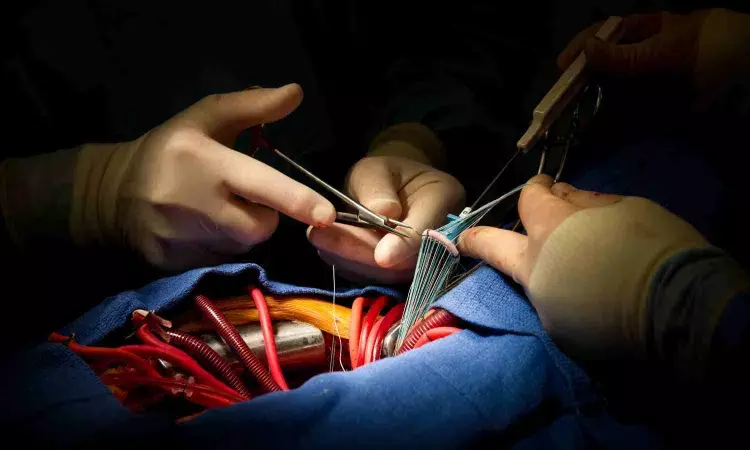- Home
- Medical news & Guidelines
- Anesthesiology
- Cardiology and CTVS
- Critical Care
- Dentistry
- Dermatology
- Diabetes and Endocrinology
- ENT
- Gastroenterology
- Medicine
- Nephrology
- Neurology
- Obstretics-Gynaecology
- Oncology
- Ophthalmology
- Orthopaedics
- Pediatrics-Neonatology
- Psychiatry
- Pulmonology
- Radiology
- Surgery
- Urology
- Laboratory Medicine
- Diet
- Nursing
- Paramedical
- Physiotherapy
- Health news
- Fact Check
- Bone Health Fact Check
- Brain Health Fact Check
- Cancer Related Fact Check
- Child Care Fact Check
- Dental and oral health fact check
- Diabetes and metabolic health fact check
- Diet and Nutrition Fact Check
- Eye and ENT Care Fact Check
- Fitness fact check
- Gut health fact check
- Heart health fact check
- Kidney health fact check
- Medical education fact check
- Men's health fact check
- Respiratory fact check
- Skin and hair care fact check
- Vaccine and Immunization fact check
- Women's health fact check
- AYUSH
- State News
- Andaman and Nicobar Islands
- Andhra Pradesh
- Arunachal Pradesh
- Assam
- Bihar
- Chandigarh
- Chattisgarh
- Dadra and Nagar Haveli
- Daman and Diu
- Delhi
- Goa
- Gujarat
- Haryana
- Himachal Pradesh
- Jammu & Kashmir
- Jharkhand
- Karnataka
- Kerala
- Ladakh
- Lakshadweep
- Madhya Pradesh
- Maharashtra
- Manipur
- Meghalaya
- Mizoram
- Nagaland
- Odisha
- Puducherry
- Punjab
- Rajasthan
- Sikkim
- Tamil Nadu
- Telangana
- Tripura
- Uttar Pradesh
- Uttrakhand
- West Bengal
- Medical Education
- Industry
Upper-extremity approach for secondary access safer for patients undergoing transfemoral TAVI: JAMA

A new study published in the Journal of American Medical Association showed that the upper-extremity route for secondary access was linked to reduced clinically significant access site-related bleeding in patients receiving transfemoral transcatheter aortic valve implantation (TAVI) when compared to the traditional lower-extremity technique.
During transfemoral transcatheter aortic valve implantation, an upper-extremity secondary access technique may lessen hemorrhage associated with clinically significant secondary access sites. In order to examine the safety and effectiveness of an upper-extremity approach vs a lower-extremity approach in patients having TAVI, this study by Bohdan Nosyk and team was carried out.
This randomized clinical trial ran from November 28, 2022 to November 15, 2023, with a 30-day follow-up at four TAVI locations in the Netherlands. Eligibility was initially assessed, and only patients with severe aortic stenosis and no contraindications for upper- or lower-extremity secondary access were notified of the trial and invited to participate. For secondary access during TAVI, the participants were randomly assigned to either the upper- or lower-extremity method (femoral artery diagnostic access and femoral vein for temporary pacing lead implantation). The primary endpoint was clinically significant bleeding in the randomized secondary access. Secondary endpoints were any clinically significant bleeding, time to mobility, secondary access failure, length of hospitalization, and procedural time.
A total of 238 individuals who were getting transfemoral TAVI were included out of 324 eligible patients. 5 out of 119 patients (4.2%) in the upper-extremity group and 16 out of 119 patients (13.4%) in the lower-extremity group experienced the primary end point. In the upper-extremity group, the incidence of any clinically significant bleeding was reduced. The length of hospital stay and the time to mobilization were the same. The upper-extremity cohort had greater rates of procedural delay and secondary access failure.
While the upper-arm vein as temporary pacemaker access led to a shorter time to mobility in patients who required lengthy temporary pacing, the secondary arterial access was the primary contributor to this decrease in access site hemorrhage. Higher access failure rates and longer procedure times were the price paid for the decrease in access site hemorrhage.
Source:
Versteeg, G. A. A., Rooijakkers, M. J. P., Hemelrijk, K. I., Vlaar, P. J., Overduin, D. C., van Wely, M. H., Aarts, H. M., van Ginkel, D.-J., van Nunen, L. X., van Geuns, R. J., van Garsse, L. A. F. M., Geuzebroek, G. S. C., Verkroost, M. W. A., Cetinyurek-Yavuz, A., Heijmen, R. H., ten Berg, J. M., Tonino, P. A. L., Delewi, R., & van Royen, N. (2024). Upper- vs Lower-Extremity Secondary Access During Transcatheter Aortic Valve Implantation. In JAMA Network Open (Vol. 7, Issue 10, p. e2438578). American Medical Association (AMA).
https://jamanetwork.com/journals/jamanetworkopen/fullarticle/2824915?
Neuroscience Masters graduate
Jacinthlyn Sylvia, a Neuroscience Master's graduate from Chennai has worked extensively in deciphering the neurobiology of cognition and motor control in aging. She also has spread-out exposure to Neurosurgery from her Bachelor’s. She is currently involved in active Neuro-Oncology research. She is an upcoming neuroscientist with a fiery passion for writing. Her news cover at Medical Dialogues feature recent discoveries and updates from the healthcare and biomedical research fields. She can be reached at editorial@medicaldialogues.in
Dr Kamal Kant Kohli-MBBS, DTCD- a chest specialist with more than 30 years of practice and a flair for writing clinical articles, Dr Kamal Kant Kohli joined Medical Dialogues as a Chief Editor of Medical News. Besides writing articles, as an editor, he proofreads and verifies all the medical content published on Medical Dialogues including those coming from journals, studies,medical conferences,guidelines etc. Email: drkohli@medicaldialogues.in. Contact no. 011-43720751


